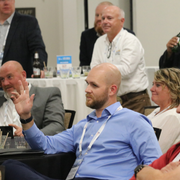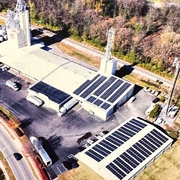IFEEDER Fodder
-

- November 11, 2024
- Partnering to Prepare the Next Generation of Industry Leaders
-
The Equipment Manufacturers Committee (EMC) Scholarship Fund began as an idea in the early 1950s at a Grain Equipment Machinery Manufacturers Association meeting. Recognizing the importance of giving back, the association started a scholarship fund and awarded one small, annual scholarship to a Kansas State University undergraduate student pursuing a career in the animal feed industry. This idea provided the spark for this program, igniting continued ideas for growing the fund over the years.
- By Guests
-

- October 25, 2024
- Ration Innovation: A Path to Reducing the Environmental Footprint of Animal Production and Pets
-
The animal food industry has an opportunity to support our customers with their environmental goals. Input from 11 U.S. and Canadian organizations representing those customers helped the Institute for Feed Education and Research (IFEEDER) identify metrics of interest relative to greenhouse gas emissions, water quality, water quantity and land and marine resource use. Collectively, those metrics provide insights into an aim to reduce their environmental footprint (learn more about those metrics in my previous blog).
- By Lara Moody
-

- October 7, 2024
- Kenny Berg Research and Education Fund Adds Value to Liquid Feed Industry
-
In my professional role at the American Feed Industry Association (AFIA), I am fortunate to have a wide variety of roles and responsibilities. Some are rooted in regulations and compliance, and some are closer to the farm gate. My heart will always lie with the latter. Perhaps working with AFIA’s Liquid Feed Committee best allows me to combine my formal education, scientific research and my passion for animal agriculture. It is through the Kenny Berg Liquid Feed Research and Education Fund, managed by the Institute for Feed Education and Research, that I’ve seen many valuable research projects come to life.
- By Paul Davis, Ph.D.
-

- September 26, 2024
- Powering Profitability: How Feed Industry Companies are Addressing Energy Use for Long-Term Sustainability
-
Energy, including fuel, electricity, heating, cooling and steam generation, is a significant cost for the feed industry. Several members of the American Feed Industry Association (AFIA) have been working to reduce energy costs by switching to more efficient equipment, developing more efficient processes and investing in renewable energy generation.
- By Erica Burson
-

- September 9, 2024
- Where Are Our Customers Focusing Their Sustainability Efforts?
-
It is one thing to consider our own animal food industry’s sustainability efforts, but it is equally important to consider the needs of our customers. We, being members of the feed and pet food industry, are an upstream source within their supply chain, but we may be well positioned to help them meet their identified goals and targets.
- By Lara Moody
-

- August 14, 2024
- Worker Safety is a Fundamental Aspect of Corporate Sustainability
-
Earlier in my career, as a contractor, I attended a transportation company meeting. Agenda item one was to participate in a safety briefing, where we learned where the exits were, any hazards we could encounter and what to do in an emergency. This impressed upon me that this company’s culture prioritized safety for its customers and workers.
- By Erica Burson
-

- July 25, 2024
- Evolving to Meet the Animal Food Industry's Future Needs Requires Your Support
-
We all seek to be good stewards and know firsthand that agriculture is inextricably tied to stewardship. We live that on a daily basis. However, considering the high stakes we face on sustainability, including evolving consumer demands and government regulation, all American Feed Industry Association (AFIA) members should lean on the Institute for Feed Education and Research (IFEEDER) as a partner and resource, regardless of where we are at on our sustainability journeys.
- By Guest
-

- July 1, 2024
- Updating Our Feed and Pet Food Consumption Data
-
This year, the Institute for Feed Education and Research (IFEEDER) initiated work on a project to update its pet food and feed ingredient consumption reports. The goal is to provide transparent data, quantifying the numerous ingredients used to feed livestock, poultry, fish and pets in the United States. These reports serve as some of the best reference materials available for those discussing matters impacting the U.S. animal food value chain. IFEEDER is the only public charity investing in this kind of research to inform decisions in the animal food industry.
- By Taylor Lekin
-

- July 16, 2024
- New IFEEDER Resource Showcases Industry Sustainability Stories
-
Sure, greenhouse gas emission reductions often get the limelight when it comes to corporate sustainability programs, but sustainability goes much broader than climate change. Consider the issues that matter most to them, i.e., conducting a “materiality assessment,” as a key step in deciding where the company should focus its sustainability efforts to make an impact. This concept can be confusing, so I break it down here and explain a new resource that the Institute for Feed Education and Research is launching to help companies understand it even better.
- By Lara Moody
-

- June 6, 2024
- Perspectives on a Year of Growth
-
As I close out my term as chair of the Institute for Feed Education and Research’s Board of Trustees, I am filled with pride and gratitude for the incredible accomplishments of our entire team. IFEEDER has truly become a trusted resource for the animal food industry and our stakeholders. Let’s take a moment to reflect on our successes and recognize the areas where the team has made significant impacts.
- By Guest